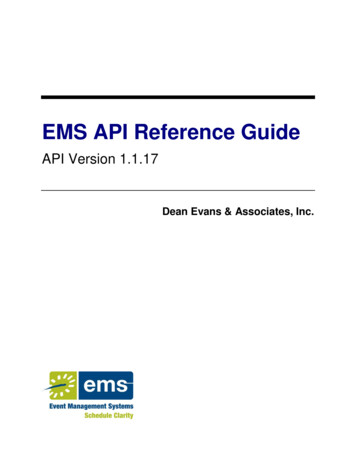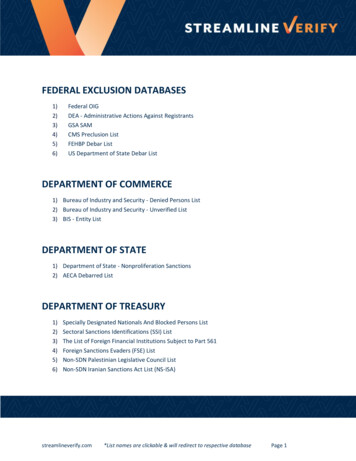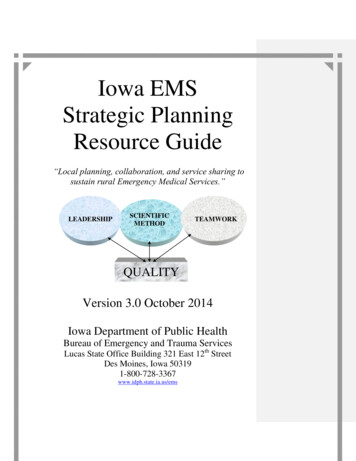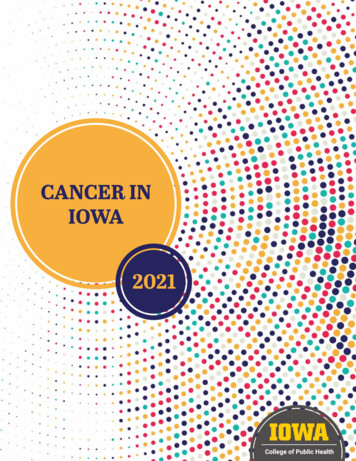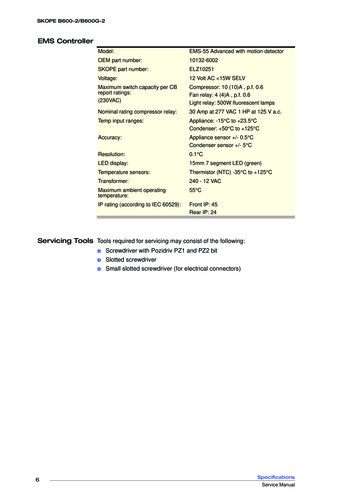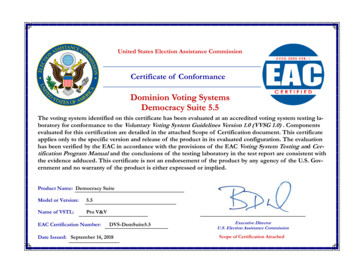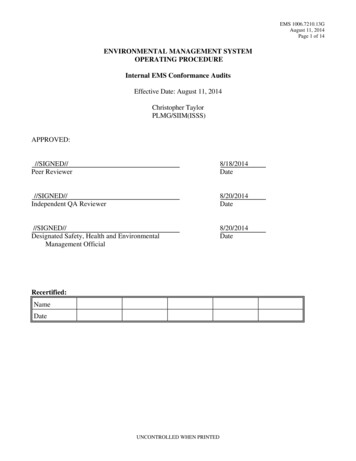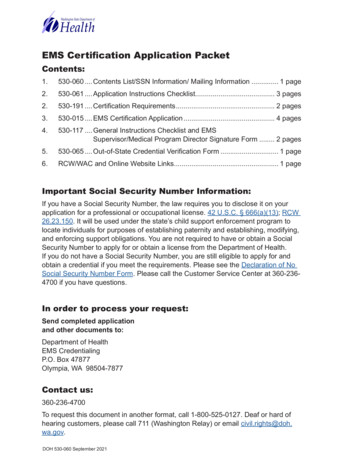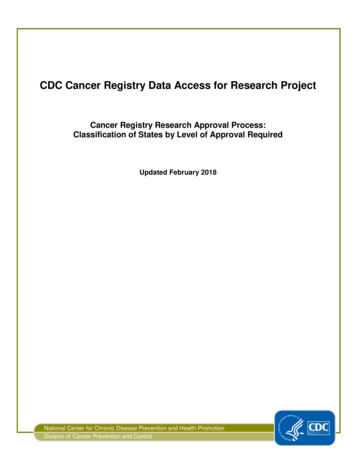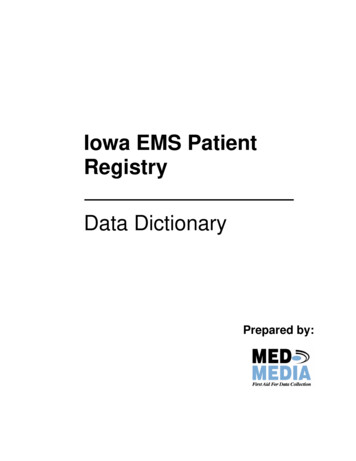
Transcription
Iowa EMS PatientRegistryData DictionaryPrepared by:
Version 2.0 12/21/2006Iowa EMS Patient RegistryTable of ContentHistory of IEMSPR: . 6NEMSIS Explanation: . 6Data Dictionary Format:. 7NEMSIS Common Null Values: . 9EMS Dataset . code (Patient Care Report Number) . 11Incident Number . 12EMS Agency Number. 13EMS Unit Call Sign (EMS Unit Number) . 14Type of Service Requested (Dispatch Type) . 15Primary Role of Unit. 17Incident / Patient Disposition. 19Patient’s First Name. 22Patient’s Last Name . 23Date of Birth . 24Age. 25Age Units . 26Gender. 27Patient Street Address . 28Patient’s City of Residence. 29Patient’s State of Residence. 30Zip Code of Patient’s Residence. 31Social Security Number . 32Race. 33Ethnicity. 35Crewmember Certification Type . 36Crewmember Certification Number . 38Crewmember Role . 40PSAP Call Date/Time . 42Unit Notified by Dispatch Date/Time. 43Unit Enroute Date/Time. 44Unit Arrived on Scene Date/Time (Arrive Scene). 45Arrived at Patient Date/Time (Arrive Patient). 46Unit Left Scene Date/Time (Depart Scene) . 47Time Arrival at Facility/Destination Date/Time (Arrive Destination) . 48Unit Back In Service Date/Time (Available). 49Unit Back at Home Location . 50Incident or Onset Date / Time. 51Type of Dispatch Delay . 52Page 2Copyright 2006, Iowa Department of Public Health, Bureau of EMS & Med-Media, Inc.
Version 2.0 65.66.67.68.69.70.71.72.73.74.75.76.77.78.79.Type of Response Delay . 53Type of Scene Delay. 54Type of Transport Delay. 55Type of Turn-around Delay . 56Response Mode to Scene (Lights or Sirens to Scene) . 57Transport Mode From Scene (Lights or sirens used from scene). 58Incident Address . 59Incident City/County FIPS. 60Incident Zip Code . 62Incident GPS Location. 63Location Type . 64Destination Transferred To Code (Receiving Agency) . 66Destination Zip Code . 68Destination Type. 69Destination Determination . 71CMS Service Level (Nature of Incident) . 72Prior Aid. 73Prior Aid Performed By . 74Outcome of Prior Aid. 75Vital Signs Date/Time. 76Pulse Rate. 77Respiratory Rate. 79Systolic Blood Pressure . 81Diastolic Blood Pressure. 83Blood Pressure Method. 85Skin Assessment . 86Glasgow Eye Opening Component. 87Glasgow Verbal Component. 89Glasgow Motor Component. 91Initial Cardiac Rhythm. 93Final Cardiac Rhythm (at Destination) . 95Cardiac Arrest . 97Cardiac Arrest Etiology . 98Resuscitation Attempted . 99Witnessed Cardiac Arrest . 100Estimated Time of Arrest Prior to EMS Arrival. 101Time/Date Resuscitation Discontinued. 102Any Return of Spontaneous Circulation . 103Possible Injury (Injury Present) . 104Cause of Injury. 106Height of Fall . 108Intent of Injury . 109Number of Patient at Scene. 110Mass Casualty Incident . 111EMD Performed. 112Page 3Copyright 2006, Iowa Department of Public Health, Bureau of EMS & Med-Media, Inc.
Version 2.0 120.121.122.Complaint Reported by Dispatch. 113Primary Symptom . 115Other Associated Symptoms. 117Provider Impression . 119Providers Secondary Impression. 121Chief Complaint Organ System . 123Alcohol / Drug Use Indicators . 125Injury Matrix External / Skin. 127Injury Matrix Head . 129Injury Matrix Face . 130Injury Matrix Neck . 131Injury Matrix Thorax . 132Injury Matrix Abdomen . 133Injury Matrix Spine. 134Injury Matrix Upper Extremities . 135Injury Matrix Pelvis . 136Injury Matrix Lower Extremities . 137Injury Matrix Unspecified. 138Safety Devices . 139Airbag Deployment. 141Motor Vehicle Impact. 142Injury Indicators . 143Seat Row Location of Patient in Vehicle. 144Position of Patient in the Seat of the Vehicle . 145Procedure – Date/Time Performed . 146Procedure – Crewmember Certification Number. 147Procedure or Treatment Name. 148Procedure Successful. 151Number of Procedure Attempts. 152Procedure Complications. 153Procedure Authorization. 155Medication – Date/Time Administered . 156Medication – Crewmember Certification Number. 157Medication Name . 158Medication Complications. 160Medication Authorization. 162Primary Method of Payment. 163Condition Code Number. 164Emergency Department Disposition. 167Hospital Disposition . 168Software Creator. 169Software Name . 170Software Version . 171Demographic Dataset . 172Page 4Copyright 2006, Iowa Department of Public Health, Bureau of EMS & Med-Media, Inc.
Version 2.0 133.134.135.136.137.138.EMS Agency Number . 173EMS Agency State. 174EMS Agency County. 175Level of Service. 176Organizational Type . 177Organizational Status. 178Statistical Year. 179Total Service Size Area . 180Total Service Area Population. 181911 Call Volume Per Year. 182EMS Dispatch Volume Per Year. 183EMS Transport Volume Per Year . 184EMS Patient Contact Volume Per Year . 185EMS Agency Time Zone. 186National Provider Identifier. 187Agency Contact Zip Code . 188Appendixes . 189Appendix A . 190EMS Agency List . 190Appendix B . 200Health Facility List. 200Appendix C . 217Iowa City/County FIPS . 217Appendix D . 277Medication List . 277Appendix E . 280Iowa County FIPS Codes . 280Appendix F . 283State FIPS Codes. 283Page 5Copyright 2006, Iowa Department of Public Health, Bureau of EMS & Med-Media, Inc.
Version 2.0 12/21/2006Iowa Electronic EMS ReportingHistory of IEMSPR:An Iowa Department of Public Health, Bureau of EMS (IDPH) data committee consisting ofrepresentatives from the IDPH, the trauma registry, and field providers created the IEMSPRdataset in 2003. Originally consisting of 97-elements the IEMSPR dataset provided datacollection to the IDPH for 3 years. The IDPH early on was committed to participation inNEMSIS and developed their system during the very early years of NEMSIS conception. Therewas no way the IDPH could fully anticipate the final NEMSIS process as it matured over thepast years. This version 2 of the IEMSPR data dictionary incorporates the NEMSIS nationaldata elements along with some of the original data elements that the IDPH requires to provideadequate monitoring and reporting of Emergency Medical Services (EMS) activity in the State ofIowa.NEMSIS Explanation:In 2001 the National Association of EMS Directors in conjunction with the National HighwayTraffic Safety Administration (NHTSA) and the Trauma/EMS systems program of HealthResources and Services Administration (HRSA) agreed to develop a national EMS database.From this agreement the NEMSIS project was grown. In 2003 the member states initiated amemorandum of understanding stating that they “recognized the need for EMS data collection atthe national level” and agreed to abide by the assignment of “specific definitions to a set of dataelements identified as desirable to be collected on a national level”. Between 2003 and 2005 theNEMSIS project developed an EMS and demographic dataset compiling them into a databookwith a defined Extended Markup Language (XML) schema to facilitate transport of the databetween systems. The databook consists of two datasets; the first is referred to as thedemographic dataset. This dataset collects information on the submitting agency, their vehicles,personnel, stations, medical equipment, protocols and medical direction. The second is referredto as the EMS dataset and collects information on the event or patient encounter. The elementscan be used to build an extensive patient care report for medical reporting purposes as well asdata collection. The current databook includes over 400 data elements that are recommended tobe included in an EMS data collection system and are also referred to as the Gold set. Knowingthe difficulty in collecting this many elements from end users, NEMSIS has created a subset ofthe data elements known as “National Data Elements” also referred as the Silver set. The Silversubset consists of a total of 83 elements, 67 elements (13 mandatory) in the EMS dataset and 16elements (8 mandatory) in the demographic dataset. NEMSIS and NHTSA require that states atminimum must collect the “National Data Elements” for submission to the national EMSdatabase. In April of 2006 the final release of the NEMSIS databook was published andsoftware vendor compliance testing initiated. NEMSIS and NHTSA are now requesting states tosubmit their data to the national EMS database.NEMSIS is attempting to remove the difficulty for EMS software vendors in conductingbusiness in multiple regions or states. The movement to an accepted standardized datadictionary and XML with a standardized format removes the complaints of software vendors inmodifying their software between customers in different regions or states. NEMSIS offers freecompliance tools and certification process for vendors to become NEMSIS compliant. ThesePage 6Copyright 2006, Iowa Department of Public Health, Bureau of EMS & Med-Media, Inc.
Version 2.0 12/21/2006benefits assist to eliminate the noncompliance of EMS agencies in submitting data to theIEMSPR system.Data Dictionary Format:Each data element is presented using the following template. The Consensus Panel considered itimportant to provide sufficient detail about each data element to justify its inclusion in theuniform data set, as well as to assist agencies, which seek to implement a data collection system.When a data element requires specific categories, these are listed in the data item specification("Field Values"). The Panel recognizes that the lists, which are included in this dictionary areimperfect, but definitions of these lists have been debated for many years without resolution.This data dictionary is not designed to provide all information and explanation of the NHTSA 2(NEMSIS 2.2.1) datasets, XML and XSD structure. Persons interested in learning more aboutNEMSIS or development for NEMSIS compliance should contact NEMSIS at www.nemesis.orgThis document is to be used by software developers and EMS agencies to understand the requestfor a data element, reference acceptable values for data elements, reference the correspondingNEMSIS data dictionary identifier number, identify the business rules associated with anelement’s submission, denote any variations from the original NEMSIS structure deemednecessary by the IDPH. Submitting agencies are required to be using NEMSIS Gold or Silvercompliance certified software with the XSD modifications noted in this document.Submitted XML record sets will be processed against the IEMSPR XSD for submissioncompliance. Submitted records with elements that fail the submission screening and are noted as‘record will be rejected’ will fail that complete record’s entry into the IEMSPR database.Submitted records with elements that fail the submission screening and are noted as ‘will bemarked as non-compliant’ will allow that record’s entry into the IEMSPR database. Noncompliance marking is to alert the EMS agency, the software vendor, and the IDPH of asubmission that does not conform to the IDPH expected completeness or standard of an EMSrecord. The label of “non-compliant” is not a negative term in isolated occurrences. It is aconcern when this occurs on the same element frequently or an agency has a high number ofnon-compliance markings. It is really meant to provide a quality assurance means to improvedata collection by the end user and vendors. There is no way a system can be built that will be100% fool proof to ensure the best data and still allow edge cases to be entered. Drawingattention to the occurrence allows all parties to evaluate the cause of the non-compliance. Thiswill allow either the agency or software vendor to correct misconceptions on the collection of thedata or the IDPH to identify that the element business rules is not valid. The IDPH will providean XSD file for testing using the free testing software available from NEMSIS.Definition of the Priority items:Mandatory: These are elements that are required on all incidents. Failure to provide themandatory element will flag the record of the incident to NOT be accepted into the IEMSPRdatabase. Correction of the deficiency is required to properly submit the incident.Essential: These are elements that are to be completed on incidents where they pertain asidentified in the Business Rules section for the particular element. If they are missing or arePage 7Copyright 2006, Iowa Department of Public Health, Bureau of EMS & Med-Media, Inc.
Version 2.0 12/21/2006invalid the, the record will NOT be accepted by the IEMSPR database. When they do notpertain the vendor should follow XSD structure rules.Desirable: These are elements that are strongly requested but may not be possible tocollect on all incidents. If the item could have been collected based on the incident then the fieldwould be marked ‘Non-Complaint’.#Element NumberName of Data Element: NamePriority: Mandatory or Essential or DesirableDefinition: Short definition of data elementNational Element: Identifies if this element is part of the NEMSIS NationalElement (Silver) list. If noted ‘modified’ then Iowa hasmade changes to the element to provide better datacollection.NHTSA 2: Length of data elementXML: Specifics the NEMSIS XML format and the XSDdefinitions.Field Values: Defined data elements - alternative descriptions of thedata element values or attributes.Content: Detailed discussion of definition and content.Discussion and Justification: Provide further details and justify the data element.Business Rules: Provide information on the requirements for and to a data element to enforcedata integrity and submission compliance.Technical Comments: Additional information which may be of use to individuals setting up adata collection system.Page 8Copyright 2006, Iowa Department of Public Health, Bureau of EMS & Med-Media, Inc.
Version 2.0 12/21/2006NEMSIS Common Null Values:These values are to be used in each of the Demographic and EMS Data Elements described inthis document, which have been defined to accept the E00 Null Values. For any collection ofdata to be of value and reliably represent what was intended, a strong commitment must be madeto ensure the correct documentation of incomplete data. The described data integrity methodmust be followed with the IEMSPR dataset. For data elements being electronically stored in adatabase or moved from one database to another using XML, the indicated values should beapplied when a data element is empty or contains a null value.Not Applicable: (Code -25) At the time of an EMS patient care report documentation,information requested was “Not Applicable” to the EMS or patient event. This indicates that it
NEMSIS data dictionary identifier number, identify the business rules associated with an element's submission, denote any variations from the original NEMSIS structure deemed necessary by the IDPH. Submitting agencies are required to be using NEMSIS Gold or Silver compliance certified software with the XSD modifications noted in this document.
